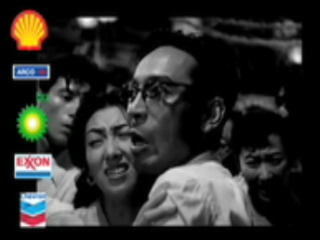Unpublished
Mashups & Web 2.0 API Directory | 3.0 | Blog
Submitted by New Media Rights last modified Thu, 09/20/2007 - 10:42pm
Unpublished
Submitted by New Media Rights last modified Thu, 09/20/2007 - 10:42pm
Submitted by New Media Rights last modified Fri, 02/01/2008 - 12:41pm
Submitted by New Media Rights last modified Fri, 02/01/2008 - 12:40pm
Submitted by New Media Rights last modified Fri, 02/01/2008 - 12:38pm
Submitted by New Media Rights last modified Fri, 02/01/2008 - 12:39pm
Submitted by New Media Rights last modified Fri, 02/01/2008 - 12:38pm
Submitted by New Media Rights last modified Fri, 02/22/2008 - 12:50pm
 This video uses copyrighted clips from the original Godzilla movie. The use of the clips constitutes Fair Use because it is a parody. The familiar icon of Godzilla is recontextualized as "Gaszilla," a terrifying monster that represents greedy big oil companies and outrageously high gas prices.
This video uses copyrighted clips from the original Godzilla movie. The use of the clips constitutes Fair Use because it is a parody. The familiar icon of Godzilla is recontextualized as "Gaszilla," a terrifying monster that represents greedy big oil companies and outrageously high gas prices.
When we originally made this video, there were only a few corporate logos which appeared on the text frames between the Godzilla movie footage. There was considerable debate. Was the Godzilla footage altered enough to constitute clear Fair Use? Was the character of the work as a whole, a parody by nature, enough to get around the use of largely unchanged video?
There was no question that our video (just over 45 sec in length) did not threaten the market of the work as a whole. We thought we were OK, but in order to make sure our video was "clear" Fair Use, we added corporate logos into the original footage (over Gaszilla's face, on the woman's forehead, etc.). In the end it probably makes the video's message a little clearer, either way it was an interesting lesson in how the law can influence a creative work.
Submitted by New Media Rights last modified Thu, 01/31/2008 - 11:42am
Submitted by New Media Rights last modified Thu, 01/31/2008 - 11:49am
Learn about our legal services for: App Developers, Artists & Graphic Designers, Bloggers & Journalists, Clothing Designers, Entrepreneurs, E-commerce Business People & Startups, Filmmakers & YouTube creators, Public Broadcasting producers,Game Developers, Internet users & Smartphone users, Makers, Musicians, Non-Profits, Photographers, Scholars, Researchers, and Writers and Publishers.